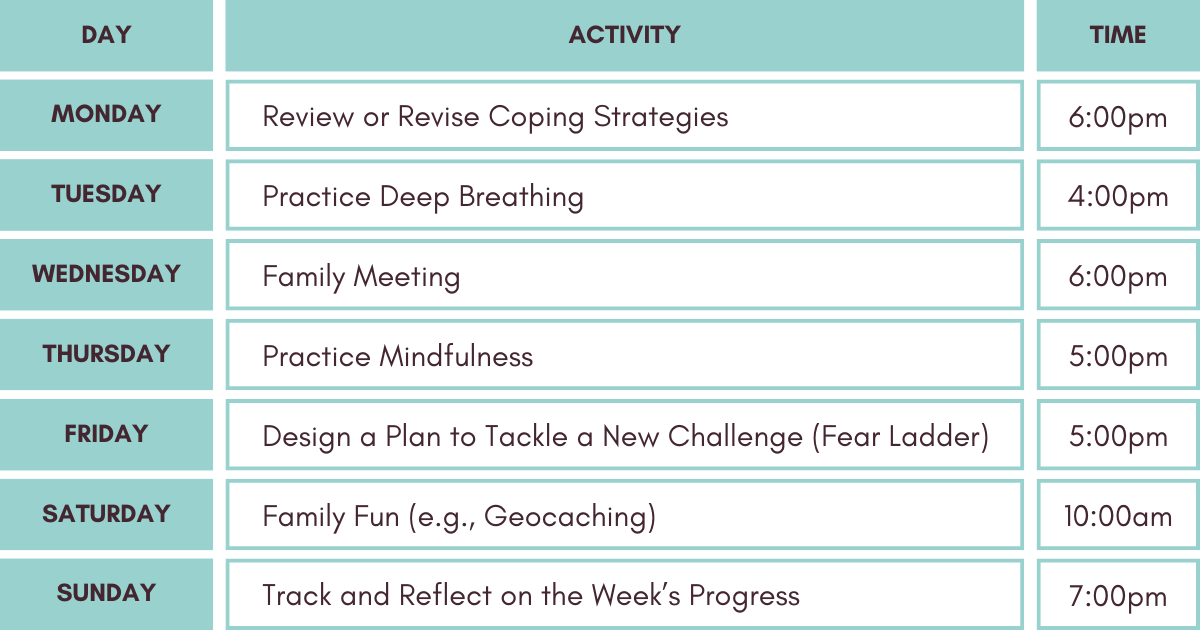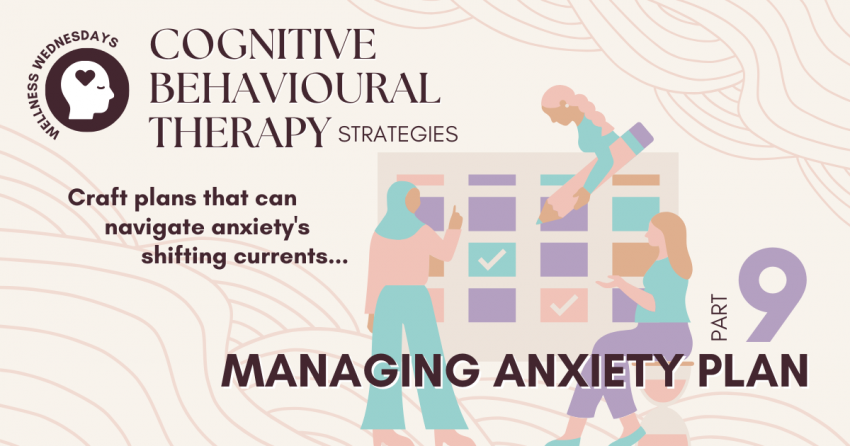Anxiety is not a static condition; it evolves over time and can manifest differently as a child grows. This necessitates an approach that is both flexible and adaptive. A Managing Anxiety Plan (MAP) helps in identifying triggers, developing coping strategies, and setting realistic goals that can be modified as needed.
Key Components of a Managing Anxiety Plan (MAP)
Identification of Red Flags and Warning Signs
- Recognize Triggers: Help your child learn to identify what situations or events trigger their anxiety. These could be stressful situations like tests, changes in routine, or social interactions.
- Warning Signs: Teach them to recognize the early signs of anxiety, such as changes in mood, physical symptoms like stomachaches or headaches, and behavioural changes like trouble sleeping or sudden changes in school performance.
Developing Coping Strategies
- Practice Regularly: Consistent practice of coping strategies is crucial. Techniques like deep breathing, mindfulness, and positive self-talk should become second nature.
- Gradual Exposure: Gradual exposure to anxiety-provoking situations can help children desensitize and build confidence. Create a hierarchy of fears and gradually work through them, starting with the least anxiety-inducing situations.
- Family Involvement: Regular check-ins, weekly family meetings, and using calendars like the one below to schedule practice sessions help in maintaining a structured approach.

- Use of Visual Aids: Utilize visual aids like a fear thermometer or a chart to help children quantify and express their anxiety levels.
- Tools and Apps: Incorporate tools and apps designed to aid in practicing coping strategies, such as mindfulness apps or journals.
Planning for Lapses and Relapses
- Coping Mechanisms: Develop a plan for what to do if anxiety returns or intensifies. This could include revisiting previously successful strategies or trying new techniques.
- Self-Kindness: Emphasize that lapses are normal and part of the learning process. Encourage children to be kind to themselves and view setbacks as opportunities for growth. Embed self-kindness into daily activities using positive storytelling, role modeling, and building positive routines like asking, “What’s something you did today that made you feel good about yourself?” at bedtime.
- Support System: Ensure there is a robust support system in place. Children should feel they can rely on family, friends, and professionals for encouragement and guidance.
Supporting Your Child Through Lapses and Relapses
Timely intervention is critical in preventing a lapse (a brief interruption in progress) from turning into a relapse (a complete return to earlier patterns). Here’s how to effectively support your child:
Regular Monitoring and Check-Ins
Maintain regular communication to monitor progress and catch any early signs of lapses. This proactive approach helps in addressing issues before they escalate. Recommend specific tools for monitoring progress, such as anxiety diaries or checklists. These tools can help track patterns and identify areas for improvement.

Encouraging Self-Reflection
After a lapse, engage in a discussion about what happened and how similar situations can be managed in the future. This reflective practice aids in learning and growth. Use specific questions or prompts to guide self-reflection, such as “What thoughts went through your mind during the anxiety-provoking situation?” and “What did you do that helped you feel better?”
Maintaining a Healthy Lifestyle
- Nutrition: Maintain a balanced diet by distinguishing between “everyday foods” and “sometimes foods.” “Everyday foods” like fruits, vegetables, whole grains, lean proteins, and low-fat dairy should form the core of their diet for optimal growth and health. “Sometimes foods” such as candy, sugary drinks, and fast food should be consumed sparingly due to their high sugar and fat content and low nutrient value. Teaching this distinction fosters lifelong healthy eating habits.
- Sleep: Establish a consistent bedtime routine to ensure your child gets 9-11 hours of sleep. Adequate sleep is crucial for their physical growth and repair, brain function, emotional regulation, and immune system support, promoting overall health and well-being.
- Physical Activity: Encourage your child to engage in activities they enjoy, such as sports, dancing, or walking the dog. Physical activity releases endorphins, improving mood and reducing stress. It enhances sleep quality, energy levels, and promotes healthy growth by strengthening muscles and bones. Regular exercise boosts cognitive function, concentration, and cardiovascular health, and also supports psychological well-being by enhancing self-esteem and social skills through group activities.
- Relaxation Techniques: Introduce additional relaxation techniques such as progressive muscle relaxation or guided imagery to provide a variety of options for coping.
Fostering Joy and Purpose
- Fun Activities: Ensure your child engages in activities they love. Create a list of things that fill their “wellness bucket” and incorporate these into their routine, especially during tough times.
- Social Connections: Help your child develop social skills and build friendships. Connection with peers is crucial for emotional well-being.
- Passion Projects: Support your child in finding and pursuing their passions. Redirecting focus to interests in nature, cooking, science, or photography can be powerful tools in managing anxiety.
Creating and maintaining a MAP is an effective CBT strategy for managing anxiety for people, no matter the age. By identifying triggers, developing coping strategies, planning for lapses, and ensuring a supportive environment, children can navigate their anxiety more effectively. Regular monitoring, healthy lifestyle choices, and fostering joy and purpose are critical components in sustaining progress. Remember, setbacks are part of the journey, and with a solid MAP, your child can build resilience and continue on their path to success.
The next and final installment on CBT strategies brings our 10-part series full circle by shifting the focus to us, the caregivers. Learn how your role, from avoiding reinforcing behaviours to modeling bravery, is crucial in managing your child’s anxiety. Discover how your involvement and self-care can significantly enhance your child’s progress in their wellness journey.


